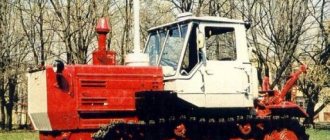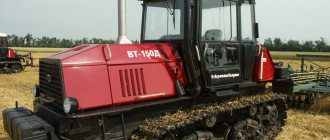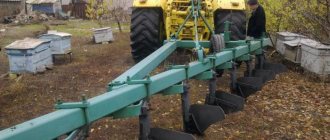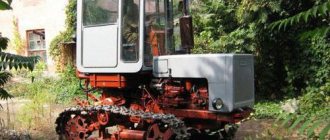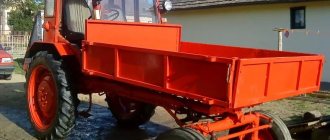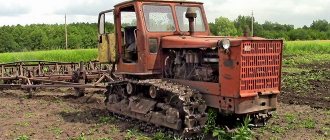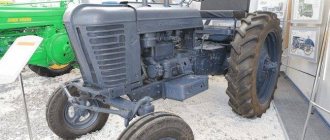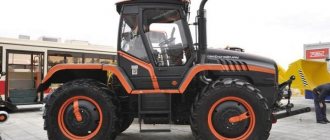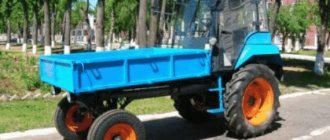From 1974 to the 21st century
T-150 is an energy-rich agricultural general-purpose crawler tractor produced by the Kharkov Tractor Plant. Produced from 1974 until recently. The most common is the energy-rich wheeled tractor T-150K, which is maximally unified with it. The differences between them are in the running systems, turning mechanisms, frames, gearboxes (unified by elements) and control systems. The development and mass production of a family of wheeled and tracked tractors that are not just related, but have the highest degree of unification, is a very difficult task. Only Soviet industry and the John Deere corporation could cope with it. About the tracked T-150 – in this publication.
Design Features
The chassis of the T-150 tractor is based on a rigid-type supporting frame, which includes two powerful longitudinal channel (box-shaped) spars, transversely connected by the front and three intermediate steel beams - cross beams, connected by rivets. Two propulsion bogies with a caterpillar belt of forty-six links each, drive sprockets, guide rollers with tension devices and shock absorbers, support and support wheels are attached to the frame through a spring suspension block.
The turning control of the tracked version of the vehicle is steering. It is also possible to include different gears on each track. Therefore, you can turn a heavy vehicle around almost in one place.
In the wheeled version, T-150K, the frame consists of two parts, hingedly connected, with the ability to rotate in a horizontal plane. On the front half-frame there is a motor, a gearbox, a cabin and a diesel fuel tank. On the rear semi-frame there is a hinged system, which is designed to secure implements. Both tractor axles, rear and front, are driven. In this case, the rear one can be turned off.
On the T-150 tractor the engine is located at the front. A clutch and a dual-flow gearbox are rigidly attached to the rear of the engine, the two output shafts of which are connected by cardan drives to the right and left bevel main gears mounted in the rear axle. The main gears are connected to the planetary final drives, on which the track chain sprockets are mounted.
The tractor can be turned in two ways. The kinematic method involves engaging, using hydraulic clutches, different gears on the left and right sides. With the kinematic turning method, both tracks remain driving (active) and the entire weight of the tractor is used to create traction force. The power method consists of reducing the oil pressure in the hydraulic clutch of the lagging side. When turning the tractor by force, the tractor is controlled by the steering wheel. The smallest turning radius is ensured by turning on the brake of the desired side, after completely disabling the hydraulic clutch.
A cabin and a diesel fuel tank with a capacity of 315 liters are installed on the gearbox. The gearbox includes transport, traction (slow), work mode and reverse. Gear shifting (there are four in total, for each of the listed modes) is carried out by hydraulic couplings - without stopping, under load and in motion. The brakes are band brakes, with two tightening branches. Hydraulic equipment: separate separate-unit system for controlling mounted and trailed machines; separate system for steering and gear shift control. The steering is hydromechanical.
Pneumatic equipment: control of the clutch and trailer brakes.
Electrical equipment: on-board network with an internal voltage of 12 V. Starter voltage – 24V. Rechargeable batteries – 6ST-190A3 (2 pcs.)
The tractor's hitch is hydraulic, single-cylinder, with 2- and 3-point adjustment.
T-150 engines
The main engine of the T-150 tractor, which, in fact, was originally developed for it, is the SMD-60 diesel engine, produced by the Kharkov tractor diesel plant "Sickle and Hammer". This is a six-cylinder V-shaped liquid-cooled diesel engine equipped with turbocharging. Its operating power is 150 horsepower. The diesel engine is started by a starting gasoline engine, which, in turn, is started by an electric starter.
After production of the SMD-60 engine ceased, a six-cylinder V-shaped, liquid-cooled YaMZ-236D3 engine was installed on the tractor - without turbocharging, but with an operating power of 170 horsepower. Its manufacturer is Yaroslavl Motor).
SMD-60.
T-150 engines are distinguished by the following technical characteristics (in parentheses are numbers for the YaMZ-236D3 version):
- Power – 150 l. With. (175).
- At a rotation speed of 2000 rpm (2100).
- Working volume – 9.15 liters (11.15).
- Weight – 0.95 t (1.00).
- Diesel fuel consumption – 217 g/kWh (220).
YaMZ-236D3.
Also, the tracked T-150s were equipped with diesel engines of the YaMZ-236M2-59 model:
- Power – 180 hp
- Rated rotation speed – 2100 rpm.
- Specific fuel consumption at rated engine power is 245 g/kWh (180 g/hp/h).
- Maximum torque – 667 N.m, at 1250-1450 rpm.
To facilitate starting the tractor engine at low air temperatures, the use of a pre-start heater PZHB-300 is provided.
Engine SMD-60
All modifications of tractors are equipped with diesel six-cylinder four-stroke supercharged SMD-60 engines with a 150-horsepower rated power. They were developed specifically for these machines, have a V-shaped arrangement of cylinders and liquid cooling.
The engine start is double: from the cab, using an electric starter, a starting gasoline engine is started, which serves to spin up the main unit. The T150 tractor is equipped with a three-stage system of highly efficient air purification supplied to the fuel system. It consists of an inertial oil (fine filter), two-stage (has ejection removal of settling dust) and a dry cyclone filter.
To make it easier to start the engine at temperatures below -5ºС, a pre-start heater PZHB-300 is provided.
Transmission
The designs of gearboxes for tracked and wheeled versions of the tractor are unified, the main gears are made in the form of planetary gearboxes. In the tracked version of the T-150, the gearbox is dual-flow, with the ability to transfer movement to the selected track. On the T-150K wheeled tractor, torque is transmitted to the drive axles from the gearbox through a transfer case. The gearbox is also equipped with a power take-off shaft, which drives the implements.
The gearbox of the T-150 crawler tractor is multi-range (with slow/traction, working, transport and reverse). In each of these ranges there are four gears, switched by hydraulic clutches without interrupting the power flow. But the ranges are switched only when the tractor is completely stopped. Also from the gearbox is the PTO drive – the power take-off shaft.
The left and right output shafts of the gearbox are equipped with personal hydraulic clutches that connect these shafts to the driven gears of all gears. When changing gears, the hydraulic clutch of the next gear is first engaged, after which the hydraulic clutch of the previous gear is turned off. For a moment, both clutches remain engaged, and this ensures a seamless shifting pattern.
Tractor fuel consumption. Calculation rules, standards – Fuel consumption
| MTZ fuel consumption standards for 1 hour or 100 km. Lubricating oil consumption rates for tractor maintenance are taken in relation to consumed diesel fuel according to the norm and are given in Table 2. The increased traction parameters of the engine made it possible to make the unit a universal modification, which is often used for transporting large-sized solids. and bulk cargo in quarries and factories;. |
- Malfunctions in the diesel engine.
- Incorrect travel speed.
- Incorrect (frequent) gear shifting.
- Heavy loads on the tractor.
- Aggressive driving style.
Chassis and suspension
The T-150 crawler tractor moves with the help of two caterpillar chains, each of which is located on two sprung balancer suspension carriages and two support rollers. The propulsion unit has coil springs and hydraulic shock absorbers, which are designed to reduce shocks from collisions with various bumps and obstacles.
The tractor is equipped with a spring-balance suspension with four spring-balance carriages, each of which is equipped with two swing axes. The tracks are 420 mm wide. Link pitch – 170 mm.
Self-calculation of fuel consumption
The operator's cabin in the HTZ-150K is panel-mounted, closed, with two unsprung passenger seats with a backrest adjustable for tilt, and a sprung driver's seat with a hydraulic shock absorber, adjustable for height and weight, and a variable backrest tilt. The control of the agricultural machine is carried out using standard hydraulic steel cylinders, which move the semi-frames in different directions in relation to the hinge.
Cabin T-150
The T-150 tractor cab is a two-seater cabin, noise-, dust- and protected, and since 2013, also equipped with a safety cage. The cabin is equipped with heating, ventilation, windshield wipers, and a sun visor. There are rear-view mirrors and a device for blowing glass.
The cabin has two soft seats. The main thing is sprung; it can be adjusted in height. The cabin is equipped with lighting, a heater, a thermos for water, a place for a first aid kit and hooks for hanging clothes.
Analogs
Analogues of the HTZ-150K are the tractors HTA-200V “Slobozhanets” and T-150. The HTZ-150K itself is now actually a modification of the HTZ-17221 model, which again can be considered as its analogue.
Differences from its predecessor - the T-74 crawler tractor
The T-150 differs from its predecessor in increased operating weight (one and a half times) and diesel engine power (more than twice). Also in its design, a shift of the center of gravity forward, relative to the middle of the supporting surface, is implemented. This allows, when applying traction force, to equalize the pressure along the entire length of the support surface of the track chain. The center of gravity was shifted by separating the gearbox with the turning mechanism from the rear axle and moving them forward, directly to the engine.
Compared to the T-74, the T-150 provides a significant increase in productivity by operating at higher speeds and with greater thrust. It reduces the harmful effects on the fertile soil layer - pressure and slipping. Transmitting power in 2 streams can significantly reduce loads, strengthen the durability of all transmission components, reduce its dimensions and raise ground clearance. In terms of working conditions, the T-150, of course, was much preferable to the more archaic T-74.
In comparison with the wheeled version - the T-150K tractor
Compared to its wheeled version, the T-150 has a very low transport speed and cannot travel on paved roads. There are real difficulties when aggregating a crawler tractor with heavy mounted implements - due to its shorter wheelbase.
The advantages of the tracked T-150, compared to the wheeled version, are: reduction of harmful effects on the ground (specific pressure by 2 times, and slipping by three times); increase in traction force by about 20-30 percent; higher productivity of the tractor unit; lower (10% less) diesel fuel consumption.
Dimensional and mass parameters
The T-150 has a classic front-engine layout. Main overall dimensions and weight characteristics of the tractor: • Weight without operating fluids and fuel – 7535 kg; in running order with full fuel – 8135 kg. Distribution of masses between the axles:
• front axle - 5200 kg;
• rear axle - 2935 kg. Overall dimensions:
• length with attachment - 5795 mm; along the edge of the rear wings - 5580 mm. • width at narrow track -2220 mm; with a wide one - 2400 mm. • Height: with fan-dust separator - 2945 mm; with climate control - 3165 mm. • Wheelbase (distance between the front and rear axles) - 2860 mm. • Track – 1860 and 1680 mm depending on the selected wheel installation option. • Ground clearance at tire air pressure of 0.12 – 0.18 MPa is at least 400 mm. The overall weight and technical characteristics of the tractor provide it with high off-road capability. The vehicle has the ability to ford water bodies up to one meter deep. The tractor is capable of moving on a slope with an elevation angle of at least 40 degrees, with a trailer and a full load of up to 14 degrees. The machine has good maneuverability, the minimum turning radius does not exceed 6.7 m on the outer track.
Bulldozer modification
Based on the T-150 tracked tractor, a modification of the T-150D with bulldozer equipment was developed. This crawler tractor was routinely equipped with a non-rotating bulldozer blade 05-09-25-06, designed for energy-intensive agricultural and road construction work. The width of this standard bulldozer blade of the T-150D tractor is 2520 mm, the lifting height is 800 mm, and the lowering depth is 400 mm.
Maintenance
Maintenance A feature of both tracked and wheeled tractors is their easy maintenance. This equipment is intended for use over a long period of time. Before each departure, you should check and, if necessary, add fuel, coolant and oil, check the functionality of the brake and steering systems, and the battery charge.
The engine oil should be changed after 500 hours of operation. In summer it is recommended to use oil of the M-10G2k brand, in winter - M-10DM. Transmission oil must be replaced once a year, before starting operation or after 1000 operating hours.
Main types of faults
Many owners of the T-150 tractor note a problem with the cardan drive.
If there is a lot of heating of this node:
Check the radial clearance in the needle bearings.
- If the gap is more than 0.5 mm, then it is necessary to replace the cross together with the bearings.
- If it is less than 0.5 mm, then simply lubricate this unit additionally.
If there is radial runout of the cardan shafts:
Check for radial movement of the gearbox flanges.
If their fastening becomes loose, remove the propeller shafts and tighten the bolts and nuts securing the flanges.
The following reasons could cause the hydraulic pump to not lift the attachment:
- It's off;
- Foreign particles have fallen onto the working edge of the bypass valve seat;
- Cold oil.
Technical specifications in numbers
- Traction class – 3 t.
- Operating weight – 8.25 tons.
- Overall dimensions: length – 4.325 m; width – 1.85 m; height – 2.895 m.
- Base – 1.86 m; track - 1.435 m.
- Road (agrotechnical) clearance – 300 mm.
- Maximum forward – 15.65 km/h; back – 7.80 km/h.
- Lowest speed: forward – 4.30 km/h; back – 5.80 km/h.
- The power take-off shaft is two-speed, with a rotation speed of 1000 or 540 rpm.
- Track width – 1.45 m.
- Track width – 420 mm.
- Specific soil pressure is 0.46 kg/cm2 (for the wheeled version - 3.42 kg/cm2).
- The lifting capacity of the attachment is 3.5 tons.
- Fuel tank capacity – 315 liters of fuel. There were also tractors with 430-liter fuel tanks.
- Filling parameters: engine oil - 19.8 l, steering oil - 33 l, gearbox - 38 l, hydraulic system - 50 l, drive axle - 34 l, PTO gearbox - 3.6 l, coolant - 41 l.
- Maximum load capacity – 4200 kg.
- Pump capacity – 86 l./min.
- The number of free pairs of distributor hydraulic outlets is 2.
- Turning radius – 2.35 m.
Owner reviews and areas of application
The main advantage of using the T-150 crawler tractor is the prevention of soil compaction, while maintaining the fertile layer. The use of this tractor allows you to perform agricultural work in difficult soil and climatic conditions, with high traction characteristics. T-150s were effectively used (and some continue to be used) in the following work: pre-sowing and main tillage on large plots of land - plowing, land cultivation; sowing work using productive wide-cut sowing complexes; procurement of feed and laying silage for storage; cleaning work in combination with specialized equipment.
The versatility and high performance of the T-150 tractor provides the ability to use a wide range of trailed specialized equipment - more than fifty items in total. A powerful motor, decent operating speed, and a pendulum mechanism for coupling trailed equipment allow the machine to be used for arable work, towing seeders, cultivators, harrows, sprayers, etc. The machine is effective in forming and filling silo pits. Crawler tractors T-150 and bulldozer modification T-150D have been used, and continue to be used, in road and industrial construction, forestry, land reclamation, quarrying and mining.
In reviews, owners and machine operators of T-150 tracked tractors evaluate this equipment extremely positively as extremely reliable, unpretentious and durable. The T-150 rarely breaks down, it is very easy to maintain and repairable: it has easy access to the main components; a small number of lubrication points reduces maintenance and repair time; spare parts and consumables are inexpensive.
The disadvantages of this model include: high diesel fuel consumption; a short wheelbase, which does not allow to provide the required parameters for towing wide-cut plows; the need to exert significant effort when using the steering column. Also, if the plots of land for cultivation are scattered, which is why you have to wander from one to another, then using tracks turns out to be a long, fuel-intensive and generally inconvenient process. And in our time, to these disadvantages one cannot help but add the very high cost of the tractor.
A more modern incarnation of a caterpillar tractor from the Kharkov plant is the KhTZ-181. It is more powerful than the T-150: it is equipped with an eight-cylinder diesel engine and belongs to the fourth, and not the third, traction class.
Attachment system
The T-150 wheeled tractor is a general purpose vehicle and can be used to perform a wide range of operations. List of main types of work: Agricultural
: plowing, cultivation, tillage before sowing and towing seeders, disking, as well as harvesting grain crops using a non-self-propelled combine.
Travel speed is from 7 to 14 km/h. Transport operations involving towing trailers and semi-trailers
at speeds up to 30 km/h.
Carrying out road, road construction and other types of work
using mounted and semi-mounted and towed equipment. The tractor is characterized by high energy saturation and is equipped with a specially designed towbar.
Among other things, there is a power take-off shaft for connecting the appropriate attachments. The coupling of the tractor with the machines is carried out in strict accordance with the instructions. The list of attachments and units includes: • Disc hoe with a working width of 15 m. • Plows: hoe; five-hull mounted; six-hull semi-mounted; five-body for heavy and rocky soils. • Heavy and standard disc harrows. • Cultivators in a hitch (two or three units). • Seeders. Coupling of three or four units. • Rollers for compacting. • Towed silage and corn harvesters. • Spreaders of mineral, organic, dust and liquid fertilizers. • Transport work using a two-axle semi-mounted and three-axle trailer. • Cultivator-flat cutter for deep loosening of the soil. • Needle harrow in a coupling of five devices. • Seeders-cultivators for sowing grain crops. The widespread use of the T-150 wheeled tractor is explained by its versatility and the ability to travel on public roads. Its high cross-country ability makes it indispensable for many types of agricultural work.
Cost of the T-150 caterpillar tractor
The new tractor T-150-05-09-26 (with diesel engine YaMZ-236M2-59 180 hp) costs 4,420,000 rubles. After a long period of downtime, the Kharkov Tractor Plant resumed work in February 2022. Despite the fact that, according to reports from the new management and the government of Ukraine, KhTZ produced 794 tractors in 2017 and for the first time “closed the year” with a profit rather than a loss, the warehouse balances of tractors from previous years of production are still not sold out. The demand for both classic models and modern Kharkov tractors (modernized analogues of the T-150 and T-150K) is limited by their high price.
There are few used tracked T-150s on the secondary agricultural machinery market, unlike their wheeled “brothers.” They ask for from 200,000 to 1,100,000 rubles, depending on the year of manufacture and technical condition.
Calculating the fuel consumption of tractors yourself: nuances
Determining the fuel consumption of tractors allows you to estimate the future costs of maintaining equipment. To measure the indicator, the tractor must travel 100 km. Then the amount of fuel consumed is determined. Important: the machine itself, as well as all components and assemblies, must be in full working order.
Photo source: exkavator.ru/trade There is a special formula for calculating fuel consumption
To calculate the fuel consumption rate of a machine, the following characteristics are taken: specific fuel consumption (R), power unit power in hp. (N) and a conversion factor from kW of 0.7. Fuel consumption for 1 hour is taken as P. Based on this, the calculation formula is as follows:
P=0.7*R*N
We should not forget that different models have different load capacities. In this regard, a correction factor is used in calculations. For full, incomplete, half or partial load, the following indicators are used, respectively: 1; 08; 0.6; no more than 0.5.
